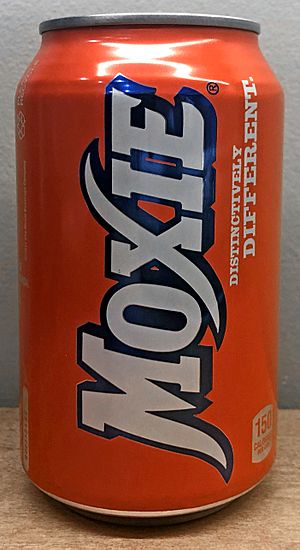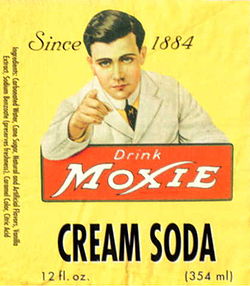Moxie facts for kids
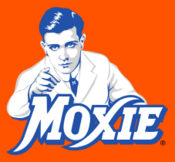 |
|
| Manufacturer | The Coca-Cola Company |
|---|---|
| Country of origin | United States |
| Region of origin | New England |
| Introduced | 1876 |
| Discontinued | Moxie Cherry Cola, Moxie Cream Soda, Moxie Orange Cream, Ted's Root Beer, Moxie Energy, Moxie Energy Citrus, Moxie Energy Explosion, Moxie Energy Thunder, Olde New England Seltzer, Moxie Blue Cream |
| Color | Caramel |
| Variants | Diet Moxie |
Moxie is a type of fizzy drink, also called a soft drink. It was one of the very first soft drinks made in large amounts in the United States. A man named Augustin Thompson created it around 1876. He first sold it as a special medicine called "Moxie Nerve Food" in Lowell, Massachusetts. People often say Moxie has a bitter taste, a bit like root beer. Its flavor comes from gentian root extract, which is a very bitter plant part used in herbal medicine.
Moxie became the official soft drink of Maine on May 10, 2005. It is still popular today, especially in the New England states. The Coca-Cola Company bought Moxie in 2018. Before that, it was made by the Moxie Beverage Company.
The name "Moxie" has also become a word in American English. It means having lots of energy, determination, or courage.
Contents
The Story of Moxie
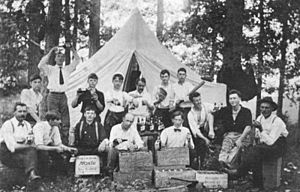
Moxie started around 1876 as a special medicine called "Moxie Nerve Food." Augustin Thompson made it in Lowell, Massachusetts. He said it had an extract from a rare plant found in South America. We now know this plant is gentian root. Thompson claimed Moxie could help with many problems. These included feeling nervous or having trouble sleeping.
Thompson said he named the drink after a friend, Lieutenant Moxie. He claimed this friend found the plant and used it as a cure-all. The company kept telling these stories about how the name began. However, the name probably comes from an Abenaki word. This word means "dark water." You can find it in names of lakes and rivers in Maine. Thompson was born and grew up in Maine.
A few years later, Thompson added soda water to his recipe. He changed the name to "Beverage Moxie Nerve Food." By 1884, he was selling Moxie in bottles. He also sold it as a syrup for soda fountains. In 1885, he got a special trademark for the name. He advertised it as "a delicious blend of bitter and sweet." Thompson passed away in 1903.
In 1907, the Moxie Nerve Food Company sued another company. They said this company copied Moxie's ingredients. They also used a similar name, "Modox." A judge first dismissed the case. But later, in New York, Moxie won a lawsuit against Modox. Modox then went out of business.
Some famous people liked Moxie. President Calvin Coolidge was known to enjoy it. Boston Red Sox baseball star Ted Williams promoted it on the radio. The company even sold a drink called "Ted's Root Beer" in the early 1960s. The writer E. B. White once said that Moxie's gentian root leads to a "good life."
Sales of Moxie went down a lot during the 1930s.
Today, a few companies still make Moxie. The Catawissa Bottling Company in Catawissa, Pennsylvania, has made it since 1945. Polar Beverages also bottles Moxie in Worcester, Massachusetts. Orca Beverage makes it in Mukilteo, Washington.
Moxie's Journey Since 1962
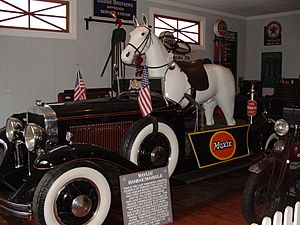
Sugar-free Diet Moxie came out in 1962. This was three years after Mad magazine started putting the Moxie logo in its articles. This helped more people learn about the drink. The magazine even gave its mascot, Alfred E. Neuman, a girlfriend named "Moxie." Because of Mad magazine, Moxie's sales went up by 10%. This led to a new advertising campaign called "Mad About Moxie."
The Moxie brand was bought by the Monarch Beverage Company in 1966. In 2007, Monarch sold it to Cornucopia Beverages. Cornucopia was owned by the Coca-Cola Bottling Company of Northern New England. This company is part of Kirin Brewery Company, which is part of Kirin Holdings Company, Limited in Japan.
Cornucopia wanted to sell Moxie to more people. They heard from many fans across the country who wanted the drink. In 2007, they started selling it in Florida. In 2010, they allowed Florida Micro Beverage Distributors to sell it there.
In 2011, Cornucopia started calling itself the Moxie Beverage Company. They created a website, DrinkMoxie.com, to promote Moxie. They also made up drink recipes that used Moxie.
Even though demand for Moxie has decreased, it is still popular in New England and Pennsylvania.
On August 28, 2018, The Coca-Cola Company announced it bought Moxie. They bought it from Coca-Cola Bottling Company of Northern New England Inc. The price was not shared.
Moxie Advertising
In the past, Moxie ads focused on it being a healthy drink. They called it "nerve food."
Moxie used catchy songs like "Make Mine Moxie!" and the slogan "Just Make It Moxie for Mine." It also had a "Moxie Man" logo. The Moxie Man has been on labels since 1906. The picture of a man pointing forward first appeared in 1911. For a long time, no one knew who the "Moxie Man" was. People even called him the "Moxie Boy" in the 1920s. An ad in 1922 offered a prize to anyone who could prove they knew the original model.
For many years, people thought the company's advertising manager, F. M. Archer, was the Moxie Man. But he would have been about 50 when the image first appeared. A history group, The Moxie Congress, found out the man was likely a model for the printing company. They believe the "Moxie Boy" was John T. Chamberlain from Revere, Massachusetts. In 2010, the Moxie Man logo was taken off labels for a short time. People thought it looked old-fashioned. But in 2011, the marketing head brought the logo back. This was because many loyal customers complained.
A special advertising tool was the Moxie Horsemobile. This was a car changed so the driver sat on a big model of a horse. The first Horsemobiles appeared around 1916. A 1935 Rolls-Royce Moxie Horsemobile was sold for $55,000 in 2011. Moxie once had about two dozen of these cars. They appeared in parades and other public events.
Other Moxie Products
There is a Moxie Energy Drink and different Olde New England Seltzers. The energy drink has a citrus flavor. It does not have Moxie's bitter gentian root taste or its caramel color. The seltzers are just fizzy waters with fruit flavors. They are sold under the Moxie brand.
Moxie ice cream is sometimes available in Maine. It has a milder flavor than the drink.
Chefs have used Moxie in cooking. Its unique flavor works well in sauces for meats like lamb. It is also used in baked beans.
"Moxie" as a Word
Moxie was first advertised as "nerve food." It was said to "strengthen the nervous system." It was also called "very healthful" and a "drink for athletes." The word "moxie" comes from the drink's name. It means "energy, determination, courage, nerve, spirit, guts." This word has been used since the 1930s. It is still used today, for example, when someone says, "This kid's got moxie!"
See also
- List of brand name soft drink products


